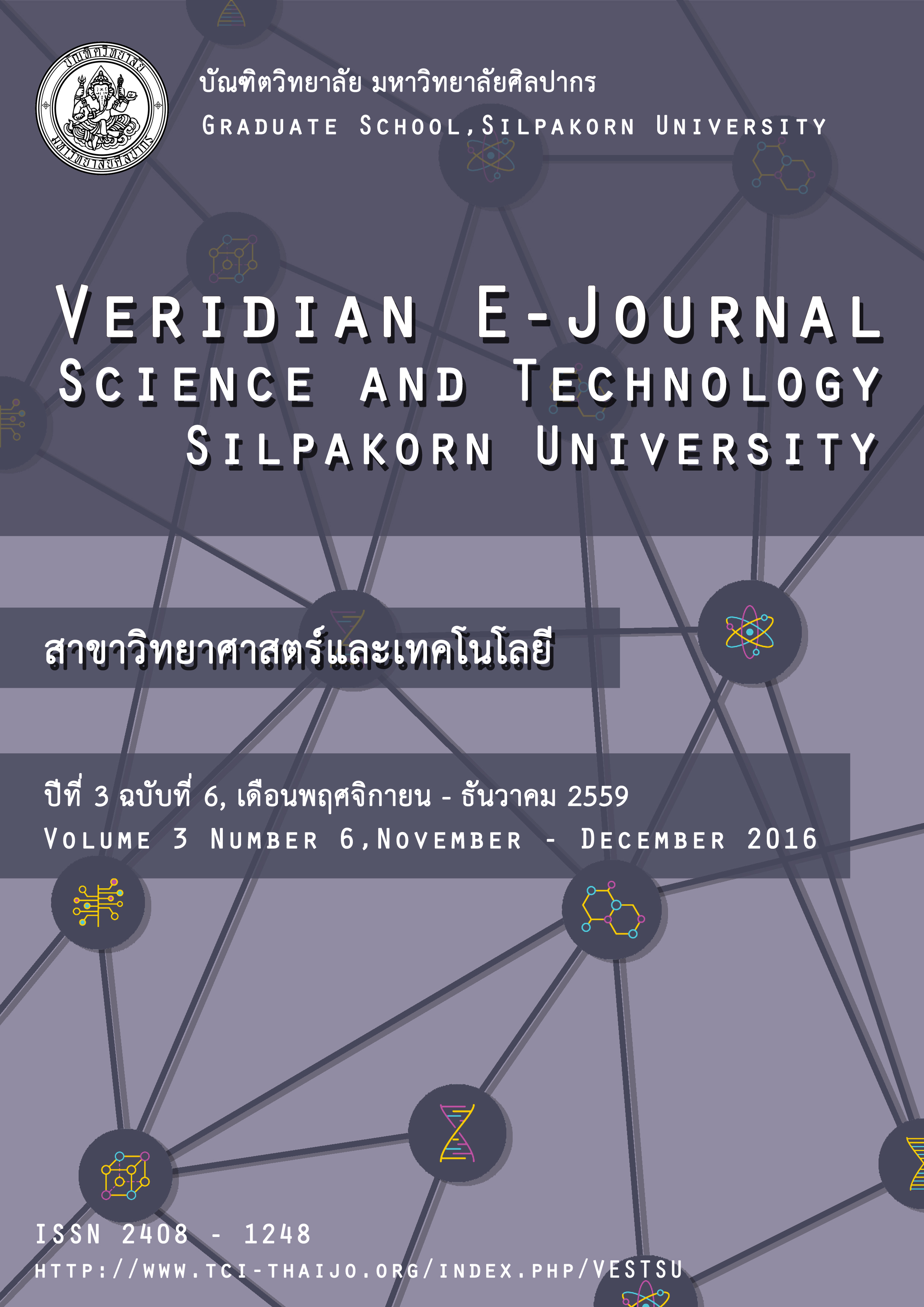ปฏิสัมพันธ์ระหว่างคุณลักษณะตัวแปรต่อความสามารถของสุนัขดมกลิ่นยาเสพติด ในการตรวจหาหลักฐานปนเปื้อน
Main Article Content
Abstract
การวิจัยครั้งนี้มีวัตถุประสงค์เพื่อศึกษาปฏิสัมพันธ์ระหว่างคุณลักษณะตัวแปรต่อความสามารถของสุนัขดมกลิ่นยาเสพติดในการตรวจหาหลักฐานปนเปื้อน เป็นการวิจัยเชิงทดลองโดยใช้แบบแผนการทดลองแฟกทอเรียล โดยการกำหนดเงื่อนไขระยะเวลา และประเภทของวัตถุที่ปนเปื้อนยาเสพติด โดยมีตัวแปรในการทดสอบ 5 ตัวแปรคือ 1) ประเภทยาเสพติด แบ่งเป็น ยาบ้าและกัญชา 2) ประเภทวัตถุที่ปนเปื้อนยาเสพติด แบ่งเป็น ธนบัตรชนิดใบละ 100 บาท ถุงพลาสติกชนิด PE พรมชนิดปูพื้นรถยนต์ และพรมสักหลาดชนิดขนสั้น 3)ระยะเวลาการอบยาเสพติด แบ่งเป็น 3 ระยะ ได้แก่ 2 นาที 10 นาที และ 20 นาที 4) ระยะเวลาที่เปิดฝาทิ้งไว้ โดยแบ่งช่วงระยะเวลาเป็น 8 ช่วง แต่ละช่วงห่างกัน 7 วัน และ 5) ความสามารถของสุนัขดมกลิ่นยาเสพติดในการตรวจหาหลักฐาน กลุ่มตัวอย่างคือสุนัขตำรวจสายพันธุ์ ลาบราดอร์ที่ผ่านการฝึก และปฎิบัติการค้นหายาเสพติดโดยเฉพาะ จำนวน 2 ตัว วิเคราะห์หาค่าสถิติพื้นฐาน ด้วยสถิติบรรยาย ได้แก่ ค่าเฉลี่ย และค่าส่วนเบี่ยงเบนมาตรฐาน วิเคราะห์ความสัมพันธ์ระหว่างปัจจัย โดยการวิเคราะห์ความแปรปรวนแบบสองทางเมื่อมีการวัดซ้ำ และเมื่อทดสอบสมมติฐานแล้วมีผลแตกต่างกันอย่างมีนัยสำคัญทางสถิติ ทำการทดสอบความแปรปรวนแบบทางเดียวเมื่อมีการวัดซ้ำ และวิเคราะห์ความแตกต่างของคะแนนเฉลี่ยเป็นรายคู่โดยใช้วิธี Bonferroni
ผลการวิจัย พบว่า
1. การทดสอบการปฏิสัมพันธ์ระหว่างคุณลักษณะตัวแปรต่อความสามารถของสุนัขดมกลิ่นยาเสพติดในการตรวจหาหลักฐานปนเปื้อน
1.1 ไม่มีปฏิสัมพันธ์ระหว่างประเภทยาเสพติดและระยะเวลาการอบยาเสพติด ต่อความสามารถของสุนัขดมกลิ่นยาเสพติดในการตรวจหาหลักฐานปนเปื้อน
1.2 มีปฏิสัมพันธ์ระหว่างประเภทยาเสพติดและประเภทวัตถุที่ปนเปื้อนยาเสพติดต่อความสามารถของสุนัขดมกลิ่นยาเสพติดในการตรวจหาหลักฐานปนเปื้อน
1.3 ไม่มีปฏิสัมพันธ์ระหว่างระยะเวลาการอบยาเสพติดและประเภทวัตถุที่ปนเปื้อนยาเสพติด ต่อความสามารถของสุนัขดมกลิ่นยาเสพติดในการตรวจหาหลักฐานปนเปื้อน
2. ยาเสพติดประเภทกัญชาและยาบ้ามีผลทำให้ความสามารถของสุนัขดมกลิ่นยาเสพติดในการตรวจหาหลักฐานปนเปื้อนแตกต่างกันอย่างมีนัยสำคัญทางสถิติที่ระดับ .05 โดยที่ยาเสพติดประเภทกัญชามีค่าเฉลี่ยความสามารถของสุนัขดมกลิ่นยาเสพติดในการตรวจหาหลักฐานปนเปื้อนสูงกว่ายาเสพติดประเภทยาบ้า
3. ระยะเวลาการอบยาเสพติดที่ 2 นาที, 10 นาที และ 20 นาทีมีผลทำให้ความสามารถของสุนัขดมกลิ่นยาเสพติดในการตรวจหาหลักฐานปนเปื้อนแตกต่างกันอย่างมีนัยสำคัญทางสถิติที่ระดับ .05 โดยที่ระยะเวลาการอบยาเสพติดที่ 20 นาทีมีค่าเฉลี่ยความสามารถของสุนัขดมกลิ่นยาเสพติดในการตรวจหาหลักฐานปนเปื้อนสูงกว่าระยะเวลาการอบยาเสพติดที่ 10 นาทีและ 2 นาทีตามลำดับ
4. ประเภทวัสดุที่ปนเปื้อนยาเสพติดต่างกัน มีผลทำให้ความสามารถของสุนัขดมกลิ่นยาเสพติดในการตรวจหาหลักฐานปนเปื้อนแตกต่างกันอย่างมีนัยสำคัญทางสถิติที่ระดับ .05
5. ระยะเวลาที่เปิดฝาทิ้งไว้ต่างกัน มีผลทำให้ความสามารถของสุนัขดมกลิ่นยาเสพติดในการตรวจหาหลักฐานปนเปื้อนแตกต่างกันอย่างมีนัยสำคัญทางสถิติที่ระดับ .05 และมีแนวโน้มที่ความสามารถของสุนัขดมกลิ่นยาเสพติดในการตรวจหาหลักฐานปนเปื้อนลดลงเมื่อระยะเวลาที่เปิดฝาทิ้งไว้เพิ่มขึ้น
The research aims to study the interaction among characteristic variables on the ability of sniffing dogs in the search for contaminated evidence. The methodology applied is experimental research. The researcher uses Factorial experimental design by monitoring time and types of contaminated materials. There are five variables including 1) types of drugs which consists of amphetamine and marijuana 2) drug contaminated materials which are 100 baht banknotes, plastic bags(polyethylene), car rugs, and woolen fabrics 3) timing for scenting the drugs are 2 ,10, and 20 minutes 4) timing for leaving the container uncover are eight periods whereas each period has seven days break, and 5) the ability of sniffing dogs to detect contaminated evidence. The samples are two Labrador’s police dogs which were trained and had practiced searching for evidence especially drugs. Then analyzes basic statistics by using descriptive statistics including mean, and standard deviation. The relationship among factors are analyzed by using Two – Way Repeated Measures ANOVA. Having examined according to the assumptions, the researcher finds significant differences. The researcher then applies One – Way Repeated Measures ANOVA and analyzes mean in pair with Bonferroni .
The results are as follows;
1. The interaction among characteristic variables on the ability of sniffing dogs to detect contaminated evidence.
1.1 There has been no interaction between drugs , timing of scenting the drugs and the ability of sniffing dogs to detect contaminated evidence.
1.2 There has been interaction between types of drugs , types of contaminated materials and the ability of sniffing dogs to detect contaminated evidence.
1.3 There has been no interaction between timing of scenting the drugs, types of drug contaminated materials and the ability of sniffing dogs to detect contaminated evidence.
2. Marijuana and amphetamine cause some significantly statistic difference at 0.5 in the ability of sniffing dogs to detect contaminated evidence. Sniffing dogs have higher average ability to detect marijuana contaminated evidence than amphetamine contaminated evidence.
3. Timing of scenting drugs at 2, 10, and 20 minutes has affected the ability of sniffing dogs to detect contaminated evidence significantly statistic at the level of 0.5. Scenting for 20 gains higher mean in the ability to detect contaminated evidence than 10 and 2 minutes respectively.
4. Different types of contaminated materials have caused significantly statistic difference in the ability of sniffing dogs to detect contaminated evidence at the level of 0.5.
5. Different timing for leaving the container uncover has caused significantly statistic difference in the ability of sniffing dogs to detect contaminated evidence at the level of 0.5 and it is likely to weaken the ability of sniffing dogs to detect contaminated evidence if the containers are opened for a longer time.

